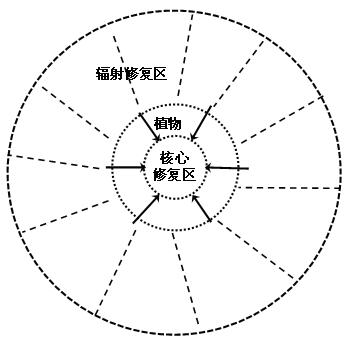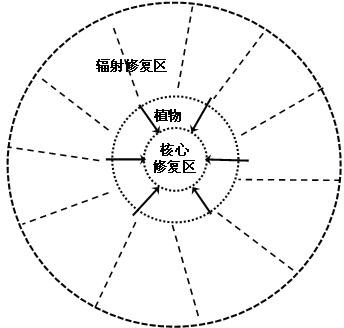Ecological restoration method for treating eutrophic water body by utilizing Nuphar sinensis
An ecological restoration and eutrophication technology, applied in chemical instruments and methods, sustainable biological treatment, biological water/sewage treatment, etc., can solve the problem of impossible automatic restoration of aquatic vegetation, improve restoration efficiency and simplify management , the effect of high economic value
- Summary
- Abstract
- Description
- Claims
- Application Information
AI Technical Summary
Problems solved by technology
Method used
Image
Examples
Embodiment 1
[0034] Embodiment 1: The method for ecological restoration of the windward lakeshore zone of a large shallow lake, specifically comprises the following steps:
[0035] (1) Using moso bamboo as a material, construct a wave-dissipating belt on the windward side of the area to be planted with Chinese pineapple grass in the shallow water area of the lakeside zone of the lake. The moso bamboo wave-dissipating belt includes double-layer wave-dissipating bamboo rafts arranged in parallel, distributed according to figure 1 According to the arrangement shown, the height of the moso bamboo above the water surface should be about 30-50 cm. For example, in lakes with large perennial water level fluctuations in summer and autumn, the height above the water surface during the construction of Moso bamboo wave-dissipating belts should be appropriately increased according to the water level fluctuations of the year, at least about 20 cm higher than the average perennial average water level ...
Embodiment 2
[0042] Embodiment 2: the ecological restoration method of city park lake, concrete implementation steps are as follows:
[0043] (1) Habitat conditions of lakeside waters. Select the relatively gentle waterfront zone with a water depth of 10-60cm as the first restoration water area. The basement is relatively well developed, and the thickness of the sediment is greater than 10cm.
[0044] (2) The colonization of Sinensis chinensis. In the first ten days of March, collect healthy underground stems from the waters of P. sinensis, which grows all year round. Use a knife to cut the underground tubers with main buds and divide them into small sections of about 6 cm, or tubers with side buds of about 3 cm. They are used as propagation materials and buried in In the sediment rich in organic matter, the appropriate burial depth is 8 cm. The plant clusters formed after planting are arranged in patches, and the actual distribution of the clusters is arranged according to the actual u...
PUM
| Property | Measurement | Unit |
|---|---|---|
| Thickness | aaaaa | aaaaa |
Abstract
Description
Claims
Application Information
 Login to View More
Login to View More - R&D
- Intellectual Property
- Life Sciences
- Materials
- Tech Scout
- Unparalleled Data Quality
- Higher Quality Content
- 60% Fewer Hallucinations
Browse by: Latest US Patents, China's latest patents, Technical Efficacy Thesaurus, Application Domain, Technology Topic, Popular Technical Reports.
© 2025 PatSnap. All rights reserved.Legal|Privacy policy|Modern Slavery Act Transparency Statement|Sitemap|About US| Contact US: help@patsnap.com



